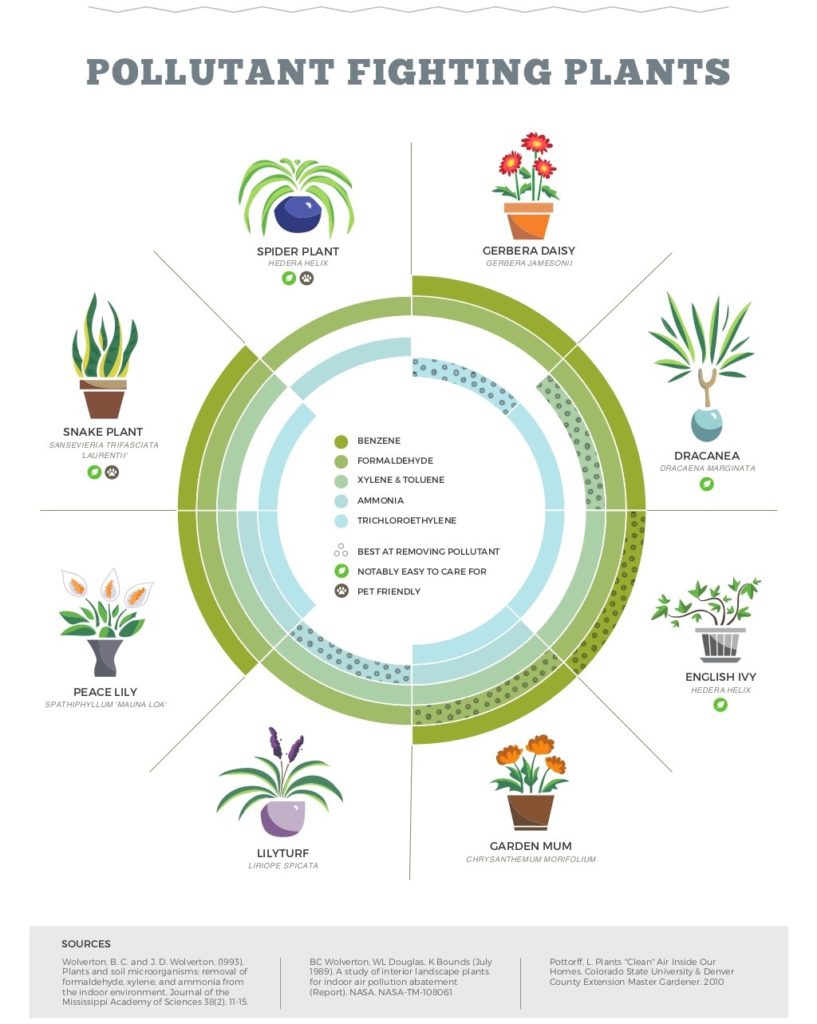Headaches, fatigue, dizziness, nausea, allergies, skin irritation, and dryness are just some of the serious health impacts from poor indoor air quality. When people experience these acute symptoms associated with poor indoor air quality, health authorities refer to their condition as Sick Building Syndrome (SBS). The Canadian Centre for Occupational Health and Safety has identified numerous pollutants affecting indoor air quality such as CO2, dust, fungi, moulds, bacteria, ozone, and volatile organic compounds (VOCs) including formaldehyde. NASA (National Aeronautics and Space Administration) studies have found that indoor air pollution averages two to five times higher than outdoors.
 There are traditional strategies to improve indoor air quality such as adequate ventilation and the removal of materials causing pollution. However, indoor plants represent a strategy to provide healthier indoor air.
There are traditional strategies to improve indoor air quality such as adequate ventilation and the removal of materials causing pollution. However, indoor plants represent a strategy to provide healthier indoor air.
The average person spends nearly 90 percent of their time inside, predominantly in homes, offices and schools. The right choice of plants can be an excellent way of improving indoor air quality and general health.
Plants can be aesthetically pleasing and excellent decorative items. Flowering plants fill rooms with colors that can improve mood, help relax the mind, and increase creativity and productivity. There are further advantages of having plants indoors—which include significant physical health benefits.
Volatile Organic Compounds (VOCs) are byproducts of a variety of materials and processes that contribute to indoor air pollution. The most common VOCs posing a risk to health are formaldehyde, benzene, and trichloroethylene. As natural air filters, plants can significantly reduce the concentration of VOCs and other harmful substances in indoor environments while enriching the oxygen content of the air. NASA (National Aeronautics and Space Administration) studies concluded that plants are capable of reducing the presence of airborne mould spores and bacteria by up to 60%.
Understandably, different plants have varying abilities to cleanse indoor pollutants. As such, it is important to make an informed decision when purchasing a plant that links the most suitable variety with the sources of VOCs present in the indoor environment.
Materials including wood, household chemicals, and plastics used in furniture and various other indoor products can release harmful compounds and gases affecting indoor air quality. Other contributors include cigarette smoke, mould and bacteria, cooking, dander from pets, and cleaning products. These factors coupled with poor ventilation contribute to “Sick Building Syndrome”, which is a combination of symptoms associated with poor indoor air quality.
In addition to removing dangerous air pollutants, plants have been shown to reduce heating and cooling costs while creating quieter working spaces.
Plants filter harmful substances out of the air and encourage healthy living conditions, acting as natural humidifiers by emitting water vapor and creating a comfortable atmosphere for building occupants. While any plant grown inside will help improve overall air quality, some are particularly useful in removing airborne contaminants as noted in the preceding discussion.
Improving indoor air quality and your health and those of your family members is easy. Simply find the plants you like and beautify your home while also improving the quality of air you breathe.
The Best Plants to Fight Pollution and Decrease Sick Building Syndrome

Source: http://www.hypothesisgroup.com/blog/2015/8/27/hypothesis-infographic-go-green-to-breathe-clean





